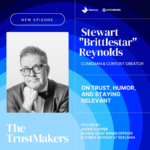By Jenn Cringoli, Account Director, ASV
Not all brand memories are made with a handshake and a business card. Sometimes, they linger on the tongue—a citrusy fizz from a custom soda, a surprising twist on a familiar snack, or the deep comfort of coffee that tastes like home. In the ever-competitive arena of experiential marketing, taste is quietly taking center stage as a tool to stir emotion, create connection, and anchor brand identity in memory.
For years, sight and sound have dominated brand activations: Think vibrant visuals, pulsating music, immersive digital displays. But now, as marketers seek deeper ways to stand out in crowded trade show halls and live events, taste is being rediscovered not just as a sensory detail, but as a strategic asset. When done right, flavor can be the difference between a booth that’s visited and a brand that’s remembered.
The Science Behind Flavor and Memory
Research in sensory marketing supports what chefs and food lovers have long known: Taste is deeply tied to emotion and memory. In fact, multisensory experiences—those that activate more than one sense simultaneously—are proven to enhance recall and emotional impact. When brands add taste into the mix, they create a fuller, more immersive encounter that’s harder for the brain to file away and forget.
According to insights from the article “The Power of Sensory Marketing in Experiential Campaigns,” flavor-based experiences build emotional bridges between consumer and brand. Whether it’s the creamy indulgence of a new cheese flavor or the crisp pop of a branded soda, these curated moments of tasting can transform passive attendees into active brand participants.
And the best part? Taste doesn’t just appeal to food and beverage companies. When approached creatively, it can support virtually any brand story.
Case Studies: From Luxury Cars to Cream Cheese
Lexus might be best known for smooth rides and sleek designs, but the brand’s long-standing relationship with the culinary world tells a broader story. Through its Culinary Masters program, Lexus partners with Michelin-level chefs to craft food and beverage experiences at events like the Food & Wine Classic in Aspen, Colorado, and Charleston, South Carolina. By integrating high-end tasting into their brand activations, Lexus not only appeals to luxury sensibilities but connects with event-goers on a human, sensory level.
Volvo has followed suit, linking its identity to a premium lifestyle by sponsoring events like Pebble Beach Food & Wine. Electric vehicle maker VinFast embraced a different approach, pouring cups of traditional Vietnamese coffee at CES to give booth visitors a literal taste of the brand’s cultural roots.
On the CPG side, companies like Heinz and Philadelphia lean into sampling at festivals to build buzz and introduce new flavors. At the Food & Wine Classic in Aspen, these household names offered daily tastings, engaging the event’s discerning audience with bold new takes on familiar favorites.
Even travel brands are using flavor to elevate the customer experience. Airlines and cruise lines are collaborating with celebrity chefs to reimagine onboard dining, recognizing that what passengers taste can be as influential as what they see or hear in shaping perceptions of luxury and care.
Flavor That Fits: How to Curate Taste to Match Brand Identity
As brands explore how to incorporate flavor into their marketing, success often depends on thoughtful alignment between taste and identity. Flavor isn’t just about what tastes good—it’s about what tastes right for the brand.
That means beginning with a sensory translation of your brand values. Is your brand playful and youthful? Maybe it leans toward bold, unexpected flavor combinations. Sophisticated and elegant? Think curated tasting menus or fine dining elements. Innovative and tech-forward? Partner with experimental chefs or feature molecular gastronomy.
Audience matters, too. Culture and age can significantly shape flavor preferences, so it’s essential to design tasting experiences that resonate with who your consumers are—and what they crave.
Presentation also plays a crucial role. The dish or drink doesn’t just need to taste good; it should reflect your brand’s visual and emotional tone. Consider how elements like local sourcing, ingredient seasonality, or even the number of flavor options offered can subtly reinforce your message.
One brand might offer a simple, high-quality espresso to underscore a minimalist ethos. Another might go full-sensory with a five-item tasting flight to reflect variety and creativity. And when the budget allows, bringing in a chef partner not only elevates the experience but also communicates serious commitment to flavor as a brand pillar.
Why It Works—and Why It’s Just the Beginning
At trade shows and live events, attendees are bombarded with visuals, pitches, and giveaways. Taste offers something different: a way to slow down, engage, and experience a brand with the full attention of the senses. Done well, flavor activates emotion, sparks conversation, and leaves a literal aftertaste of the brand in a person’s mind.
As experiential marketing evolves, the brands that will stand out are those that treat taste not as an extra, but as a foundational element of storytelling. Whether it’s a cultural connection, a celebration of craft, or a nod to innovation, flavor has the potential to transform fleeting moments into something far more lasting.
And that’s something people don’t just remember—they come back for more.
About the Author
Jenn Cringoli is an account director at ASV, an event and experiential marketing outfit based in Torrance, California.











